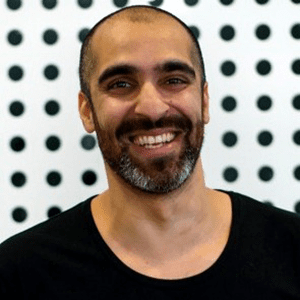

#7: Customer centricity – how do you surprise and delight your customers?
Ashton Bishop, CEO, Step Change talks about the ‘7 Customer Centric Shifts’ that business leaders need to adopt to become truly ‘Customer Centric’
Seeing the person behind the customer… Maximising the value they receive …while removing anything that reduces their ease of interaction.
Stephanie: Hello and welcome to TEC Live. Stephanie Christopher here, Chief Executive of The Executive Connection. TEC connects CEOs, executives, and business owners to the world’s largest business leader network. We’re committed to delivering actionable insights, accelerating business performance, and optimising decision making.
Today I’m talking to Ashton. Ashton is Australia’s predatory marketer. Sounds scary, I know. He’s an expert in pinpointing how brands can grow by outsmarting their competitors. However, his path as would be with Ashton anyway, was a somewhat unusual one. After graduating with a commerce and law degree, he turned his hand to street performing on the streets of Denmark, TV presenting, stand-up comedy, film directing, and even literally ran away with the circus.
He came back, he found his niche in marketing where he’s spent the last 14 years working internationally on some of the world’s biggest brands. He’s a business owner, a serial entrepreneur, a challenging, sometimes even controversial, but he’s always focused on what gets results. Ashton and I love our conversations, since we first met five years ago. This is the first time that it’s been recorded. I said to Ashton it’s just like a normal chat we have, except someone’s actually recording it. Welcome Ashton.
Ashton: Thank you Stephanie.
Stephanie: Do you know I figured out, it’s literally five years ago about this week that I met. I first met you at a Vivid event in Sydney.
Ashton: Yeah, Vivid Time Again.
Stephanie: Yeah, Vivid Time Again. Since then, our conversations are always far reaching. Today, we’re going to talk about customer centricity which sounds … Is that a lofty term for the customer’s always right, or is it something else?
Ashton: Customer centricity, not easy to say, and as a concept, not really easy to get your hand around it. Why we’ve been exploring it, documenting it, engaging with our customers, so we’ve held events around bringing together panels of industry commentators, industry leaders, and really saying, ‘What does customer centricity mean?’
Stephanie: When you say we, this is of course through your own business, Step Change.
Ashton: Through Step Change, yeah. We’ve dealt with a lot of different businesses. TEC, a lot of TEC clients, we’ve been lucky enough to work with and share within the TEC community, for best part of 10 years now. And across that, we’ve got a lot of different data points of how those businesses, those challenger businesses are redefining what it means to deliver value to customers. That’s really at the heart of it.
Stephanie: What are the key elements of that?
Ashton: The key elements of customer centricity is really understanding that things are changing. Yes, customers are demanding change, so beyond just being demanding, they’re demanding change. There’s innovators that are driving change, and often that surprise and delight comes from something that wasn’t previously imagined. Then there’s this, certainly financial sectors at the moment, there’s the regulators driving change.
Often when, especially in Australia, when something goes wrong, the legislating effect of lowest common denominator means that regulation is a big effect.
Stephanie: Surprise and delight. I love the story you told me when we were chatting a couple of weeks ago on the phone about the motel in LA, was that in LA?
Ashton: Yeah.
Stephanie: Tell me about that.
Ashton: I think it’s called Magic Castle, which is basically one of those 1970s, 1980s drive-in motels. Nothing is really speculator about the building or the place, and when you look at the photos, you go, ‘Oh, that just looks like another motel’ but you check the reviews and there’s more five star reviews than basically any other hotel in LA. It’s the most recommended. When you look into it, there’s things that they do there that are surprise and delight. They’re these lightning strikes of delighting customers.
When you go to the pool, there’s a red phone by the side of the pool. You go, ‘Oh, is that for calling the lifeguard?’ You pick the phone up, it goes, ‘Hello? Popsicle hotline.’ Then the next thing you know, there’s a waiter who comes in a full penguin suit with a tray with free popsicles. You imagine the delight of the squealing kids and adults of that joy. The keyword there was free popsicles, but the magic behind that story is that if you ask customers what they’ve wanted, the standard thing that people do is compare something to an archetype, and weigh up the difference.
If I said, ‘What’s the problem with this studio?’ You go, ‘Oh, well Ashton’s left his papers on the floor’ and you’d be able to spot all the things that are out of place. It’s very difficult to tell somebody what would surprise and delight you, because it’s outside your awareness.
Stephanie: Yeah, and I’ve gone way back now to when I would have worked perhaps preparing a tender for government, or something like that, and they’d basically say, ‘How will you surprise and delight us?’ That’s actually a really hard thing to answer, because well I don’t know what’s going to surprise you. How do you do that if you’re a business owner and you’ve got as you say, customers are demanding?
Ashton: Yeah, it’s great. You start with a premise by going, ‘I’m not going to focus my resource and attentions on filling it potholes.’ Those little bumps of annoyance. There’s a whole bunch of behavioral economics around this done by Kahneman and Tversky, Thinking Fast, Thinking Slow. What it says is basically when it comes to any sort of experience, be it a human experience, a customer experience, there’s this thing called duration neglect, is that we forget how long it goes for, and we forget all the little bits.
It’s just about how it made us feel. With the way people feel, it’s just those peak emotional moments. If you look at the Henry Ford quote, it says, ‘If I’d asked people what they wanted, I would have built a faster horse.’
Stephanie: Yeah, that’s right.
Ashton: The steps are first of all figure out your customers are probably not going to tell you what would delight them. The second thing is the only way you’re going to really be able to invest in the surprise and the delight is by stopping to try and make everything okay and make a couple of things amazing. That’s where you get the inspiration from, generally other sectors or categories, and in this they call it the Medici effect, these are lighting strike moments of when you connect previously unconnected things.
Stephanie: Right, so that’s quite risky, isn’t it?
Ashton: Absolutely.
Stephanie: I’m going to let some things go that might annoy someone. Okay.
Ashton: And that’s the wonderful thing about risk, is that people see the risk inherent within change. They don’t often see the risk inherent in not changing. I remember I was with a client once and they had had a decline year-on-year. They went, ‘Oh, we’ve got a decline year-on-year, we need to do some marketing.’ When we looked at the data, they hadn’t had a decline year-on-year. They had a decline on year, on year, on year.
Their appetite for change to resolve, that was pretty small. We just graphed it and we went, ‘Actually, given your current rate of decline, by the year X, you won’t have a problem, because you’ll be completely out of business.’
Stephanie: ‘You’ll be on the beach.’
Ashton: Yeah, you’ll be actually on the beach. It’s often making the risk of not changing real and apparent, is the first thing we need to do by saying, ‘Yeah, there’s a risk in doing it.’ When we started StepChange, we brought out, we started mid GFC, no clients, no money, basically no idea. When we didn’t have the credentials, pitch, and the documents, and the existing clients, it’s hard to get work.
We started with a no result, no invoice policy. When you’re looking at that for the first time, there’s only risk. It’s like, ‘What if we do this first client and they don’t pay? Then we’re gone.’ But over that proceeding almost 1000 jobs, I think we haven’t had one client actually claim that within the intention of what it’s designed to protect.
Stephanie: Yeah, that’s good. Can I go back to when you said about surprise and delight being joining up two things that aren’t usually connected?
Ashton: Yeah.
Stephanie: Can you give me an example of that?
Ashton: Yeah, so going back to the example we’re talking about, is silver service in swimming pools. They also went, they will do things like have for the breakfast buffets, they will have entertainment clowns, so mixing birthday parties and breakfast. They basically went, ‘What does entertainment at a kid’s birthday party look like? Let’s bring that to breakfast,’ yeah. They also have at the Magic Kingdom, they have the minibar that’s basically free. It’s like, eat as much as you want. Dry cleaning, free. That’s bringing that unusual moment of the unexpected.
If you can either bring something that’s unexpected or takeaway a pain that people expect, that’s a delight. I mean, if you look at Uber’s removal of pain, what did Uber do? It blended avatars, payments, and GPS. Three existing technologies came together, but what happened is you didn’t need to repeat where you were going five times. Lightning strike. Removed pain.
Stephanie: You just get out at the end. It still surprises me, when I think, ‘Can I just get out?’
Ashton: Yeah. And then you get out of a taxi for the first time when you’ve gone back to a taxi and they go-
Stephanie: ‘Excuse me.’
Ashton: Waving at you, yeah. But that’s really the key, of looking at from the person’s emotional state, what drives real delight, or what would remove the pain? They’re the lightning strike moments of the F me moments of like, ‘Wow, that was so amazing. We’re removing the F you moments.’ And often they’re there, but people within the existing category just won’t address and won’t face it, or won’t remove it.
Stephanie: Does this flag a shift in value in what customers perceive as value, as a supplier or a company? Can you drive a shift in perceived value in a customer?
Ashton: Absolutely. I think when you actually think about it, I love your question, Stephanie, all value is perceived value.
Stephanie: Of course it is.
Ashton: Because people, a lot of customers come to us and they say, ‘Oh, people buy on price.’ I say, ‘You can’t buy on price. You buy on value.’ Why do people want to focus on price? Because it’s easy to compare. What’s better value? $400 or $300?
Stephanie: It depends.
Ashton: If you pretend it’s for the same thing, it’s easy. That’s the real challenge for most of the businesses, especially in this challenger space, is to challenge what represents value, to really come in and say, ‘Look, if people make emotional decisions and then rational justifications, what’s emotionally engaging them?’ The thing about lightning strikes or their value delivery is right at the start, when we’re setting up that emotional connection, it matters disproportionately more than just about anything else.
Because if you set a negative tone at the start, it doesn’t matter how rational or how good, we just aren’t listening. One in the middle, and then the end matters a lot as well. The formula for a great experience is actually peak intensity, end moment, divided by two. What that looks like is actually you’re saying that we don’t compete with people in our category. We compete with the Uber experience. There’s the moment that Apple are loved by customers for and hated by competitors, is when somebody gets drunk, vomits on their phone, drops it in toilet, walks up to the Genius Bar and goes, ‘Oh, I got drunk and here’s my phone and it doesn’t work and I don’t have a receipt.’
‘Don’t worry, sir. Here, have a brand new one. I’ve upgraded you, I’ve transferred all your files, have a great day.’ That sort of experience then has, that’s what they expect from every category.
Stephanie: That’s the challenge, isn’t it?
Ashton: Yeah. Super challenging.
Stephanie: What are the kinds of things that customers are expecting now to demonstrate value?
Ashton: One of the big shifts that I think, we’re fortunate because we work across all of the ATO’s 18 different tax categories, just as you’d have members from every different tax category.
Stephanie: Yeah, I’ve never really thought of segmentation that way. ‘Hello, you fit into this tax category.’
Ashton: Yeah, the tax department doesn’t miss much. But there’s a beautiful quote that says basically the future’s here already. It’s just not evenly distributed. If you look at what’s happening in different categories or sectors, they mature at different rates. Often it’s about first of all, adding additional value, so when you talk about subjective value, there’s a subjective loading in free. People make mistakes when people, customers ask for a discount and they just go, ‘Oh, I’ll just take some money off.’
What’s the problem with that? First, you’re training customers that there was margin in there you can afford to give away. The second thing is you’re training them that that’s what they should ask for. It’s much better to understand what they’re looking for in terms of value not being equivalent, and equivalent to what. Maybe they’re comparing apples and pears. The second thing around that is there is a subjective value in free that’s far better.
If you give somebody a $200 discount, that’s far less valuable than adding an additional service-
Stephanie: For free.
Ashton: … for free that’s worth $200. People relate to it differently. They react to it differently, and the subjective value’s far different as well.
Stephanie: Does this relate in any way to a customer in a transaction like that, even if it’s a big transaction, needing to feel like they’ve won?
Ashton: That’s exactly right. There’s two types of value. There’s basically the transactional value and then the holding value. There’s the value in the service that you’ve got, and how you use it and the benefits, but then in the financial transaction around it. Was prices, and I know different categories, different sectors, but that’s immediately value creation. There was someone I was talking to once and they went, ‘I was trying to get rid of this washing machine and I left it on the side of the road outside my parents place and they wouldn’t take it. I put a for sale sign on it for $20, and it was gone in an instant.’
What they’ve done was there was the value inherent within the washing machine, but too cheap to be good. They created an extra additional value of $20, and it went.
Stephanie: Back to pricing then, I guess I’ve got a retail example I’m thinking. Because that’s the challenge with value. I’m thinking of Banana Republic. Store I love, when I’m in the states. It’s permanently 40% on sale. If it’s not for five minutes, there’s no way.
Ashton: Yeah. Effectively retail ruined it for themselves a lot. I used to love that, the Harvey Norman type, ‘Fire sale. We’ve burned the new place down, we’ve gone crazy, we’ve got nuts, I just smashed myself on the head with a sledgehammer. Everything’s going. Apple computers excepted.’ I think when you look at the world’s most valuable business, and the brand that sits behind it, and the exclusion that it had from stepping out of that fray, the question is for people, I don’t know how to win a price war. When clients come to us and say, ‘We’re in a price war, how do we win?’ I don’t know.
It’s a race to the bottom and generally everybody loses. Because as the margin comes out of the category, service levels drop, quality levels drop.
Stephanie: It’s a bit of a cycle then, isn’t it?
Ashton: It’s definitely a cycle.
Stephanie: Because then someone comes back in, creating a different view of value, which is actually good performance or something that will last, and then the money goes back up again.
Ashton: And you don’t have to play the same game. 10% off is the same in one in every tenth person shops for free. You think about the magic, the behaviors, the advocacy, the experience around that. It comes back to that pothole thing. If you stop doing the same things that are low value, where can you reinvest that? The people who we talked about lighting strike theories a lot, they go, ‘Oh, I’ll do another lightning strike and another lightning strike.’
Stephanie: They’re not anymore.
Ashton: That’s the pothole game. If you’ve got extra resources, reinvest in making that one lightning strike you’ve got even more amazing. Double down on it.
Stephanie: Wow, okay. How do you cope if there’s an engagement of whatever period of time? I love the surprise and delight at the beginning. I get the big finish. How do you navigate then when little things go wrong and, ‘I got my invoice at the wrong time’ or, ‘You said whatever, and you said I’d get Ashton, and I got Stephanie’ or whatever. How do you deal with that then?
Ashton: It’s called an upgrade. Just say, ‘You were expecting Ashton, you got Stephanie.’
Stephanie: Yeah, that’s right. Exactly.
Ashton: ‘That’s called an upgrade.’
Stephanie: Thank you Ashton. Now you’ve thrown me off, but anyway, back to this idea of the potholes. Any engagement, if you’ve got people in the customers, something’s going go wrong. How do you manage that? You can’t say, ‘Yes, but wait until we’re finished, you’re going to be so delighted.’
Ashton: Yeah, so I think the first thing is just reiterating some of the points that we’ve talked about, because it does come together, right? First thing is if you’ve won with the big emotional play upfront, people are less likely to pay attention to the negatives, than if they started off with the negative frame. It pays back many times. If you think about an equity point, you can get a compound effect for more good stuff, but you always get a second chance draw around that.
The other thing is is what you want to do is if you know there’s bad news, you want to bundle it.
Stephanie: Okay, tell me about that.
Ashton: As long as the bad news is not going to create what’s called the trough experience, which is the F you moment, you want to say, ‘During the course of this engagement, this membership, this whatever, there’s a few things that you should know about that are coming.’ We have this conversation after we’ve shown you how amazing it will be and we’ve sold you … People’s happiness today is determined by the future that they’re living into, right?
Stephanie: Yes. It’s prediction, isn’t it?
Ashton: Yes. It’s the affect. It’s called the affect heuristic. You’re making decisions today on how you think you’re going to feel. If we’ve started off with an amazing engagement, right? And we think it’s going to go well, then we’re forgiving and we’re looking for the good. We’re working towards that. If I know there’s bad stuff coming, I don’t want to surprise you with it. I want to flag it and I want to say during the course of this, it’s a relationship, there’ll be ups and downs. We’re going to end in this place, but you need to know that ba-da, ba-da, ba-da, ba-da.
If I can cluster those together, as long as I’m not creating the most negative experience, you just count that as one. You want to spread out, it’s counterintuitive. You want to spread out the good news, and you want to cluster the bad. That’s one of the things that’s really important. You also want to set your frontline staff up to be empowered.
Stephanie: We’ve been hearing that for a long time, haven’t we?
Ashton: It’s one of the, when we sat down and went through the customer centricity framework in the transition, there’s basically 12 coordinated points. They don’t all matter the most. When it comes to what matters the most is that your customer experience will never exceed your level of internal staff engagement. If your staff don’t feel supported, connected, safe, and engaged, the probability your customer experience is going to be any better than that just doesn’t happen.
When you talk about the creation of lightning strikes and the merging of that with customer experience, Zappos is very famous for that. In his book, Delivering Happiness, Tony Hsieh goes into one, a values based culture, and they basically create these mad, like a menagerie of designing weird office spaces and quirky behaviours. But frontline staff were given a large discretionary budget and told to delight customers, and they would do crazy things.
They’d stay on the phone for 16 hours or something, and they’re delivering pizzas to people while they’re on the phone, and they’re hand delivering stuff. Having a lot of fun and it’s a bit weird and it’s a bit crazy, but that was the marketing for Zappos. That was the marketing and around that, what’s amazing is that only 2% of the calls went to the call center, but that was what the brand was known for, and that’s what built it. Empowering frontline staff with the discretion to deliver against an experience.
The experience of what that looks like from a value expression has to be united, or else you just get random, but if you can clearly articulate what that you’re a little bit weird, a little bit crazy, which is Zappos type of experience is like, then staff who are empowered and resourced to deliver that become the key differentiator in that.
Stephanie: And as you said, you can’t exceed the engagement of your staff. So it always comes back to people. Everything comes back to people. You just alluded to your framework, and I know part of your framework, there’s some shifts, aren’t there? That have to happen.
Ashton: Mm-hmm (affirmative).
Stephanie: I can just say now that if anyone wants to download the whole framework, where do they get that from?
Ashton: You just go to the StepChange blog. There’ll be links available on that, or find me on LinkedIn is always another way of doing that.
Stephanie: Great, Ashton. Because it’s actually, it’s kind of complex and simple at the same time. Tell me about the shifts. What are the big shifts?
Ashton: There’s seven shifts to customer centricity. The first one is … Did you want me to go through them quickly?
Stephanie: Well, yeah, why don’t you go through them quickly?
Ashton: Sure, just real quick. Instead of moving from a place where people are moving understanding of customers to sell to them, this is shifting to understanding customers to serve them, to really understand what the needs are and be responsible for the delivery of value. From understanding what customers want, to what they value, because what customers actually say they want to actually what they value are often different things.
Stephanie: And they may not know.
Ashton: Exactly.
Stephanie: Because they may know what they want, but they may not know what they actually value.
Ashton: Or what they don’t want, and that’s the next point. And probably your question, one of your earlier questions tapped on this Stephanie, is that the greatest value we can often add to customers today is to not add something additional when you look at maturity of markets, when people start, they discount and they add something for free, and then they add more service value. Now the most successful businesses are often removing friction.
Stephanie: Yes, I like that.
Ashton: And that’s probably the question du jour, is not what I can add in. What can I take out? How can I make it easy and smooth, remove the friction? Data, instead of reporting, about predicting. That’s really machine learning and AI and that’s where it’s really going to bite and change things.
Stephanie: And that’s Amazon, isn’t it? ‘It’s time to change your toothbrush.’
Ashton: Yeah, absolutely.
Stephanie: And while you’re at, what about this, and this, and this?’
Ashton: Yep, to predict. It’s saying, or if you’ve bought this many times, then you should then have the fluoride treatment and then the airbrushing, and then the other things.
Stephanie: Yes. The airbrushing, that’s the photographer. Love the airbrushing.
Ashton: Sometimes you get beyond that. The air blasting.
Stephanie: Yeah, I think … Yeah, that’s right. The airbrushing is what I need.
Ashton: From segments to individual. I think this is really when we look at the power of marketing automation systems, to predetermine journeys that work, but then have that personalisation in it.
Stephanie: And that’s really big in everything now, isn’t it?
Ashton: Super.
Stephanie: That hyper personalisation.
Ashton: Hyper personalisation. If you look at-
Stephanie: I learned that from you.
Ashton: It’s one of the mega trends around how can you use 3D printing, data, and the intersection of different fields to create something hyper personalised for people.
Stephanie: Yeah, that’s good.
Ashton: The marketing team to the whole organisation, this is where this conversation around what does customer centricity mean? Well, doesn’t really matter what it means. Unless you get the vertical alignment from board to executive to manager to front line, and if there’s a break in that connection, it doesn’t happen. And then you need to link product to customer experience to marketing to sales. You’ve got a depth and a breadth, and unless there is a real interesting coordinating that, then probably don’t even undertake the journey.
And then it’s better results today versus investing in relationships the last a lifetime. If you look at those two metrics around all the dashboarding and the data and the reporting and the things that businesses come up with, unless you know your cost of acquiring a customer and your lifetime value, you don’t know whether you’ve got a business. That’s really that metric of if you know your customer lifetime value, know that’s trending in the right direction, then we can play with cost of customer acquisition. Business happens between those two variables.
Stephanie: I know I told you before about when I worked for an insurance company and they stated a value was customer obsession. We used to talk about is that driving slowly past a customer’s house. But what I like about what you’re saying, moving from the marketing department, or the sales department, is actually the whole organisation. That’s talking about authenticity, isn’t it?
Ashton: Yeah, it really is.
Stephanie: You can’t actually do anything about this unless you really mean it, and as a leader, you’re going to lead that, but the whole organisation is going to act with that in mind. I think Ashton, you make the complex fascinating, and for me, you also make the complex attainable as well. As always, it’s just been such a pleasure speaking to you and Ashton, thank you very much.
Ashton: Thanks Stephanie.
Stephanie: That’s TEC Live for today. CEOs are in the business of making decisions and leadership is the art of execution. I’m Stephanie Christopher and look forward to talking to you next time.



